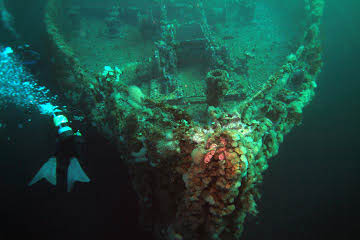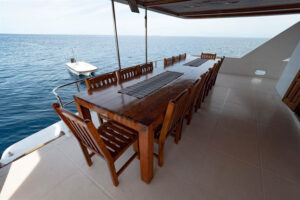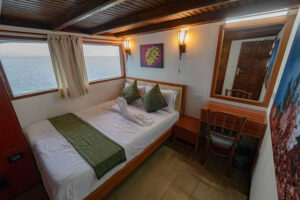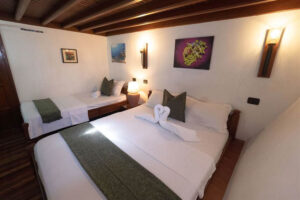“Ladies and gentlemen we are going to need to circle for a few minutes until we can get clearance to land.” For many, this announcement would be a frustration, a sign you would be late. For me it was a chance to get a bird’s-eye view of the waters I would be submerging in the next morning. Looking down, I saw Bell Island and Little Bell Island. In the waters that surround these islands lie four wrecks steeped in history.
After landing, I find my way to the baggage carousel and see a man wearing an Ocean Quest shirt, and his signature hat. With a firm handshake and a “G’day b’y, how ya been”, I had met Rick Stanley, owner of Ocean Quest. If I had not been sure already, that accent confirmed I was in St. John’s, Newfoundland.
Newfoundland is not the first place that would come to mind for many divers. It is rather remote; far away from everywhere. And let’s be honest, there’s no way the waters of the North Atlantic are warm, not even remotely warm; but here I was, setting out on what would be my greatest dive adventure to date.
Arriving at the guesthouse, it was apparent this was no regular dive bunkhouse. This is Rick’s and his wife Debbie’s home. The main level and basement had been remodelled into a warm and comfortable place for divers to stay, a kitchen like you would find in any nice home, a living room and deck with views out across the Atlantic. No, this was not a bunkhouse; this was my home for the next week.
In 1942, the world was consumed by war in Europe and the Pacific. Britain had become heavily dependent on the supply convoys crossing the Atlantic bringing much needed supplies to the allied war effort. And because of this, German U-Boats strategically targeted the convoys. The sinking merchant ships laden with war material occurred regularly as these ships attempted the trans-Atlantic voyage.
In the late summer of 1942, German U-Boat attacks on the supply chains came to the shores of Newfoundland. In September, U-513, under the command of Rolf Ruggerberg, crept into Conception Bay under cover of darkness. The Lord Strathcona and the Saganaga were anchored and loaded with iron ore. On the morning of Sept. 5, 1942, the U-513 rose to periscope depth and quickly torpedoed both ships, killing 29 crew members. The U-513 then turned towards the open Atlantic and slipped away.
Two months later, the U-518, sister to the U-513, slipped into Conception Bay and on Nov. 2 and sunk two more ships, the Rose Castle and PLM 27. Between the two ships, 30 lives were lost. Like the U-513, the U-518 slipped out of the bay despite the search efforts of a patrolling Canadian Navy Corvette.
On our first morning of diving, as would be the case every morning, the Ocean Quest van was waiting to give us a lift to the boat. With tanks analysed and gear packed and loaded, we were off to the boat, which was a one-minute drive down the hill to the dock.
The Mermaid, Ocean Quest’s dive boat, is a comfortable boat with in an indoor cabin and outdoor dive deck. The first thing I noticed was the elevator to lift divers out of the water, no climbing ladders while the boat is pitching to and fro loaded with dive gear. Fortunately, a pitching boat would not be an issue on this day. Skies were sunny and clear, with a cool ocean breeze. The ocean was calm. Crewed by Captain Bill and deckhand Jack, the Mermaid set out from dock to our destination, the PLM-27. The journey was about 40 minutes, and by the time we arrived, we were geared up. I am feeling a bit anxious as I often do on my first dive in a new location, but there is also excitement. Plunging into the ocean, the frigid waters of the North Atlantic hit hard. It’s cold! I am thankful for having brought a good warm under layer for my drysuit. I am also struck by the beauty of the very clear and very blue water. If it wasn’t for the cold, you might believe you were in the Caribbean. The water is so blue!
Four wrecks awaited us off Bell Island; the PLM-27 would be our first of the day. The Saganaga was our second dive. These two wrecks are the shallowest of the four we would dive that week. The PLM-27, sitting in 100 feet of water, was a beauty with plenty to explore and lots of ambient light. Much of the wreck sits at the 50-70 foot depth range, allowing for a longer bottom times and lots of opportunity to explore. The massive anchors that would have held the 400-foot PLM-27 in place, still hang from the sides, appearing to hold the wreck in time. The majority of the wreck, like all of the Bell Island wrecks, is still intact, allowing you to see the rooms and hallways where the crew once worked. The jewel of the PML-27 is its massive propeller, still in shape, the only one accessible of the four wrecks. It is a must see, and provides for stunning pictures.
At 110 feet, the Saganaga is the second shallowest of the wrecks, and like the others, provides an intact structure that gives divers a lot to explore. With plenty of rigging still in place, a stern gun and complete super structure, the Saganaga served to increase our appetite to dive more of the wrecks, and take in everything there is to see. Well within recreational limits, the PLM-27 and the Saganaga are advanced dives. Still, divers can take in what are some of the nicest wrecks in the world.
Getting deeper, certainly appealing to the technical diver, the Lord Strathcona and the Rose Castle are the deepest of the Bell Island wrecks. Lying at 122 feet, the Lord Strathcona amazes divers with its super structure, guns, and passageways. The Marconi room is a must see. With its communications wires still hanging within the room, one can imagine the radio operator at his post, sending and receiving messages. As with the other wrecks, the gaping torpedo holes provide access to lower parts of the ship for those with the experience and ability to penetrate into the holds.
Considered the gem of the Bell Island wrecks, the Rose Castle is the deepest, sitting at 160 feet. At this depth, the 455-foot freighter has been spared much of the damage suffered by shallower wrecks from storms, currents, and icebergs that travel through the area. It boasts an intact super structure and holds that draw you in as you glide along its length. The stern gun still stands poised for action, and like the Lord Strathcona, the Marconi room is a must see. For divers certified to go a bit deeper, the Rose Castle holds another wonderful surprise. Sitting at 165 feet, not far from the wreck is a torpedo sitting in the sand!
The wrecks of Bell Island can be described as some of the best in the world. The clear water and beautifully intact structures provide much to see and explore. With all but the Rose Castle well within the reach of recreational limits, these wrecks also provide outstanding diving for many experience levels. Even the Rose Castle, provides recreational divers the opportunity to visit her deck.
After a dive in the chilly waters of the North Atlantic, what could be better than some hot fare? That is what the crew of the Mermaid has waiting once you are back onboard, Captain Bill’s tasty homemade soup! Rumour has it you must complete both the daily dives to have the honour of enjoying his soup, but I am sure that is a flexible rule.
There’s no doubt that the Bell Islands, Newfoundland and Ocean Quest offer world-class wrecks, outstanding hospitality and a top-notch operation that should be at the top of your dive vacation list. Once you dive there, you will be drawn back, as I have.
Photos credits: Ocean Quest










1 Comment
What a great find! Never knew of this place at all. Looking forward to finding out ore and possibly scedualing a trip the place looks unbelievable and like nothing else Ive seen thus far as well and Ie dove all over Micronesia and abroad.
Thank you so much for sharing my friend, what a great read.
Cheers,